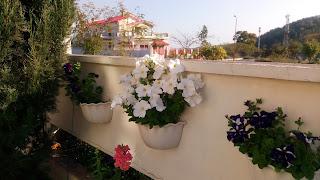DOON GARDENING SOCIETY MONTHLY
MEET MARCH 2017 – DEHRADUN 18.03.2017
The monthly meeting of the Doon Gardening Society for the month of March, 2017 was held at the residence of Mr.Satyavrat, former DGP Uttarakhand. at his residence # 65, USHA Colony, Sahastadhara Road, Dehradun on 18.03.2017 at 5.00pm. Mr.Satyavrat and Mrs. Sangeeta have been inducted into DGS as new members.
Out
of 18 members 13 members attended the meeting and 3 members had shown their
inability to do so for personal reasons and 2 members was absent.
Both
Mr. Satyavrat and Mrs. Sangeeta are keen gardeners and spend a lot of their
time in gardening.
Mr.
Satyavrat’s day starts with tea in his favorite garden spot. He enjoys the nature’s
bounty, while observing the sprouting seedlings of the newly laid out vegetable
garden or the change in size, shape and colour of the growing plants.
The
members assembled in the lawn and introduced each other.
Capt.
S K Bhandari was elected as the president for the day.
With
the permission of the President, the meeting was declared open.
Capt.
S. K.Bhandari, gave a talk on the various garden activates to be undertaken
during the month of March, 2017 with special emphasis to the fruit trees and
their care.
It
was emphasized that overall in Dehradun there was a nematode and fungus attack
on standing fruit trees. The white fly and Mealy bug attack was also prevalent.
The nematode and the fungus attack the roots of the pants and are carried
through the soil and use of infected garden tools.
The
members were advised to spray the following combustion on all the plants
specially the fruiting plants.
-In
1 liter of water dissolve 10gm Bavistin or Anustin (Carbendazin 50%) fungicide
+ 10gm Copper Oxychloride 50% WP and 10gm Fungo (Thiophanate Methyl 70% WP) and
mix it well. Spray this on all the plants to be followed after 5-7 days.
If
the damage in the plants is less than 50 % then these will survive. Plants with
more than 50 % damage and discoloured or blackish brown stem and leaves should
be de-rooted and destroyed by burning.
Prune out light infestations or dab insects with a Q-tip dipped in rubbing alcohol.
Do
not over water or over fertilise — Mealy bugs are attracted to plants with high
nitrogen levels and soft growth.
Then
try to wash off the infected area with high pressure water.
You
can purchase the insecticidal soap from a shop or make your own as given below:
Homemade
Insecticidal Soap Recipe
The
simplest insecticidal soap is nothing more than a 2% soap solution. To make
this at home, you will need:
Sprayer:
Any clean spray bottle or garden sprayer will work fine for spraying
insecticidal soap. Make sure the sprayer or bottle hasn’t been used for
herbicides.
Pure Soap: Lux or any all-natural soap. The active ingredient in insecticidal soap comes from the fatty acids in animal fat or vegetable oil, so it’s important to use the real thing.
Don’t
use detergents (which are not actually soaps), dish soaps, or any products with
degreasers, skin moisturizers, or synthetic chemicals.
Pure
Water: Tap water is fine for making insecticidal soap. If you have hard water,
you may want to use bottled water to prevent soap scum from building up on your
plants.
To
make homemade 2% insecticidal soap, mix together:
Like
any other home remedy, there are as many variations on this recipe as there are
gardeners! You can also try:
Garlic
or Pepper: To help repel chewing insects, add a teaspoon of ground red pepper
and/or garlic per gallon of water to the mix.
If
this does not affect, apply a pesticide combination Imidaclorphid17.8 % SL 2ml
+ Power Bio20 2ml in 1 liter water and drench the affected plants. To be
followed after 10 days.
I
have used it very effectively. The plants are now both green and healthier with
no trace of the mealy bugs. Imidaclorphid17.8 % SL will kill the pests and
Power Bio 20 will help the plants gain vigour.
This
was followed by a question/answer session in which Capt. Bhandari solved the
issues as well gave tips on various aspects of gardening
A
visit to the garden was undertaken. There garden was blooming with flowers as
the spring/early summer season was in full swing.
A
good collection of Bonsai plants were also on display.
This
was followed by a well laid out and sumptuous snacks and flavoured tea.
The
meeting was then declared closed and a vote of thanks was given to the Host and
Hostess.
A
few pictures of the meeting are given in the attached album.






















































